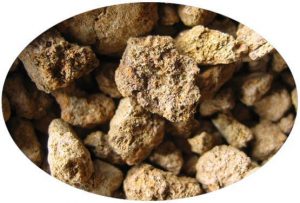Rare earth ore is important to various high-tech and green energy products, including smartphones, electric cars, wind turbines and solar panels. However, their extraction and processing present many challenges due to their complex mineralogy and low concentrations in ore deposits. Beneficiation is particularly difficult among the different steps in rare earth mining because it involves separating these elements from other minerals while maintaining their purity. Rare earth ore beneficiation solutions needs multi-stage operations such as flotation, magnetic separation, gravity separation and leaching, etc. These solutions are designed to increase the efficiency of extracting valuable metals while minimizing environmental impact and reducing costs.
Properties Of Rare Earth Ore
Rare earth ore, also known as rare earth element ore or rare earth metal ore, mainly exists in the earth’s crust as minerals. As the basic component of minerals, it exists in the mineral lattice as ionic compound, forming the basic components of minerals.
There are 17 kinds of rare earth elements: lanthanum (La), cerium (Ce), praseodymium (Pr), neodymium (Nd), promethium (Pm), samarium (Sm), europium (Eu), gadolinium (Gd), terbium (Tb ), dysprosium (Dy), holmium (Ho), erbium (Er), thulium (Tm), ytterbium (Yb), lutetium (Lu), scandium (Sc), and yttrium (Y). All are extremely precious minerals, the main raw materials of countless high-precision industries, and have important economic and strategic value.

From metallurgy, petroleum, chemical industry, glass, electronic ceramics, and people’s livelihood to stealth fighters, nuclear submarines, nuclear submarines and various industries are inseparable from rare earth. Although the amount of rare earth elements is small, as long as a small amount of rare earth elements are added to other raw materials, the quality and performance of the product can be greatly improved.
Why is rare earth Ore Beneficiation difficult
1. Complex Minerality
Rare earth ore has a variety of mineral components, and there are many useful and gangue minerals. Rare earth minerals are mainly bastnaesite and monazite. Among them, about 5% are related to heavy minerals, such as xenotime, zirconium fluorite, rutile, ilmenite, etc.; gangue ores are mostly quartz ore, feldspar, chlorite, garnet, etc. Their mosaic particle size is very small, and there is little difference in beneficiation properties from other useful and gangue minerals. For this kind of monazite ore, multiple processes such as gravity separation, magnetic separation, and electric separation need to be separated, which requires high beneficiation technology.
2. High technical requirements
There are many impurities in rare earth ores. After the rare earth concentrate is decomposed, there are more impurities in the mixed rare earth compounds, such as uranium, thorium, niobium, tantalum, titanium, zirconium, iron, calcium, silicon, fluorine, phosphorus, etc. The physical and chemical properties of rare earth elements are very similar. Most rare earth ions have a radius between two adjacent elements. After the rare earth mineral concentrate is decomposed, each element must be purified to obtain a single pure rare earth element. This process is complicated, so it requires high technology.
3. Pollution of rare earth ore
Rare earth mines have previously been mined using an “in situ leaching” mining process, in which the slurry formed can increase rare earth and metal ion levels in surface and groundwater due to changes in pH. Rare earth development and utilization technology will pollute the surrounding water and ecological environments and affect the downstream rare earth mineral elements, making it even more difficult to mine them again.
Rare earth ore beneficiation solutions
1. Gravity separation
Gravity separation mainly uses the density difference between rare earth minerals and gangue minerals. It is widely used to separate rare earth minerals and low-density quartz, calcite and other gangue minerals. It is also a pre-enrichment process stage for rare earth vein ore beneficiation. Common gravity separation equipment includes shaking table, jig, spiral chute, centrifugal concentrator, etc.
2. Magnetic Separation
Some rare earth minerals are weakly magnetic. Using the difference in specific magnetic susceptibility between them and associated gangue and other minerals, magnetic separators with different magnetic field strengths can separate rare earth minerals from other minerals. Weak magnetic separation is often used in coastal placer beneficiation to separate ilmenite and monazite. In the beneficiation of rare earth veins, to simplify the flotation process and save flotation agents, sometimes strong magnetic separation is used to pre-enrich rare earth minerals.
3. Flotation Separation
Flotation separation is a widely used beneficiation method in rare earth production. Utilizing the differences in physical and chemical properties of the surface of rare earth minerals and associated minerals, they are separated from associated gangue and other minerals by flotation to obtain concentrates.
4. Electric Separation
Rare earth minerals are poor conductors, and they can be separated from minerals with good conductivity by electrical separation by taking advantage of their different electrical conductivity from those of associated minerals. Electric separation is commonly used to separate coastal gravel and heavy sand.
While the beneficiation of rare earth ore does present significant challenges, we have solutions for the above. Optimizing beneficiation processes to ensure sustainable production is critical with the increasing demand for rare earth elements across industries. Utilize advanced technologies such as gravity separation, magnetic separation, flotation, and hydrometallurgy to improve the beneficiation efficiency of rare earth ores. JXSC will carefully consider the most suitable beneficiation process and equipment based on factors such as ore grade, mineralogy and environmental impact.